HITLER PUTS POLAND INVASION ON HOLD
Berlin, Germany • August 26, 1939
Serious discussions between the Nazi and Soviet regimes began secretly in late July 1939. On August 21 Germany announced that Foreign Minister Joachim von Ribbentrop had been invited to Moscow. Two days later the world learned that Ribbentrop and his Soviet counterpart, Vyacheslav Molotov, had initialed a neutrality pact between the hitherto antagonistic states; the pact was variously known as the Molotov-Ribbentrop Nonaggression Pact or the Nazi-Soviet Pact among other names.
With the Soviets now neutralized by treaty, Adolf Hitler ordered his attack on Poland (population just over 35 million), planned since late March 1939, to begin on this date, August 26, 1939, the date Germany officially mobilized. But at the last minute, on the evening of August 25, he hesitated. The British and French governments insisted they really would go to war with Germany if Poland were attacked—a mutual assistance pact had been signed that afternoon between Britain and Poland, a follow-up to a March 31 guarantee of Polish independence (though not, interestingly, Polish territorial integrity). Furthermore, Axis partner Benito Mussolini told Hitler that, notwithstanding their 2‑year-old bilateral military Pact of Steel, Italy would remain impartial in any war with Poland.
Faced with the prospect of taking on Britain, France, and Poland unaided, Hitler decided to avert war for the moment in favor of a full-court diplomatic press. A Swedish emissary, acting in a private capacity, shuttled between the German and British capitals with various proposals for a peaceful solution to Germany’s differences with Poland over the Polish land corridor and the ethnic German Danzig enclave (see map); both territories had been a part of pre-World War I Imperial Germany.
But the West’s last-minute hopes for a multilateral settlement were delusional though widely held: Late August polling in Great Britain showed that only one in five persons expected war to break out. Truth was, August’s shuttle diplomacy was essentially stall tactics designed to drive a wedge between Poland and its Western backers. The Poles must be shown thoroughly unreasonable by refusing to make concessions regarding an extraterritorial highway link (the Reichsautobahn Berlin-Koenigsberg) across the Corridor that would eliminate the need for Germans traveling between East Prussia and the rest of Germany to carry passports. Also, Hitler did not truly want Poland to accept his demand to hand over Danzig, whose forcible seizure he had been plotting since late 1938. Hitler rescheduled his invasion (Fall Weiss) for early Friday morning, September 1. In his bones the scheming aggressor felt sure that the coming war would not spread beyond Poland’s borders.
The Polish Land Corridor and the “Free City of Danzig” (Present-Day Gdańsk) on the Eve of War
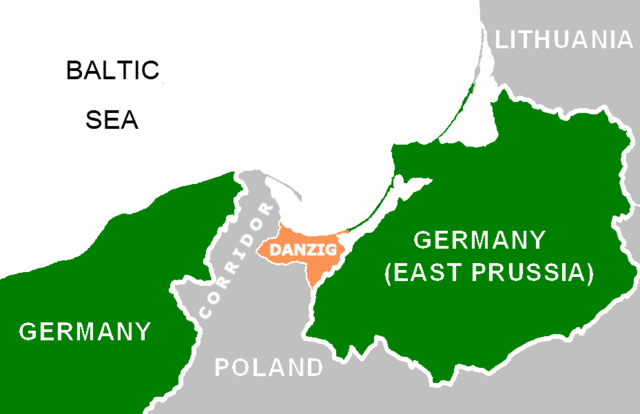 |
Above: Interwar land corridor to the Baltic Sea and the semi-autonomous “Free City of Danzig,” 1920–1939. Both creations were carved from former German territory (West Prussia’s central parts) so that newly independent Poland (since October 1918) would not be dependent on German ports for its import/export trade. In May 1933 Hitler’s Nazi Party gained control of the Danzig Senate. Like the ethnic Germans in Czechoslovakia’s Sudetenland in the mid-1930s, Danzig’s largely ethnic German community strongly agitated to be incorporated into the Fatherland.
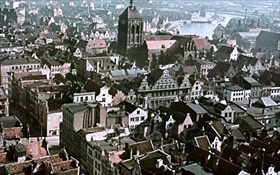 | 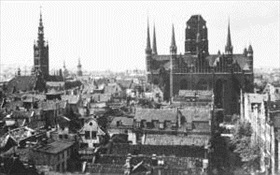 |
Left: Danzig’s then-Lutheran Supreme Parish Church of St. Mary’s (German, St. Marienkirche; Polish, Bazylika Mariacka) and the Flemish-inspired Green Gate (center of photo) built to serve as the formal residence of Polish monarchs. In 1224–1225 North German merchants from Luebeck established a presence in the area. Significant German influence appeared in the fourteenth century after the takeover of the city by the Teutonic Knights. In 1793 Danzig was annexed by the Kingdom of Prussia and became the capital of the German province of West Prussia. It remained a part of Germany until 1918, after which it was administered by a League of Nations commissioner and elected assembly. As a result of the Potsdam Agreement of 1945, Danzig (Gdańsk) became part of Poland.
![]()
Right: Danzig’s city hall (left in photograph) and St. Mary’s Church from the back. Begun in 1379, the Roman Catholic (formerly Lutheran) church is the largest brick church in the world. The church was badly damaged during the storming of Danzig city by the Red Army in March 1945. Reconstruction started in 1946, and the church was reconsecrated in 1955. Date of photograph is unknown.
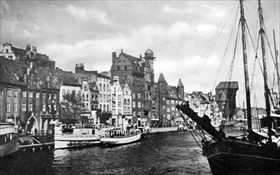 | 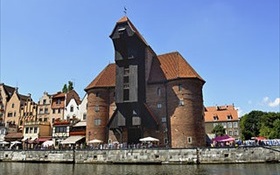 |
Left: A interwar year view of Danzig’s River Mottlau (Polish, Motława) waterfront. In the distance is the Gothic double-tower Krantor Gate (1442–1444), the best-known symbol of German Danzig.
![]()
Right: Gdańsk’s Krantor Gate in 2010. In the Soviet assault on Danzig in early 1945, the medieval gate was severely damaged—brickwork smashed and the wooden portion that housed the port crane destroyed by fire. Between 1957 and 1959, the gate was rebuilt and today serves as the city’s marine museum.
Well-Done Amateur Video of Gdańsk (Danzig), Poland, as it Appeared in 2012
![]()

 History buffs, there is good news! The Daily Chronicles of World War II is now available as an ebook for $4.99 on Amazon.com. Containing a year’s worth of dated entries from this website, the ebook brings the story of this tumultuous era to life in a compelling, authoritative, and succinct manner. Featuring inventive navigation aids, the ebook enables readers to instantly move forward or backward by month and date to different dated entries. Simple and elegant! Click
History buffs, there is good news! The Daily Chronicles of World War II is now available as an ebook for $4.99 on Amazon.com. Containing a year’s worth of dated entries from this website, the ebook brings the story of this tumultuous era to life in a compelling, authoritative, and succinct manner. Featuring inventive navigation aids, the ebook enables readers to instantly move forward or backward by month and date to different dated entries. Simple and elegant! Click 











